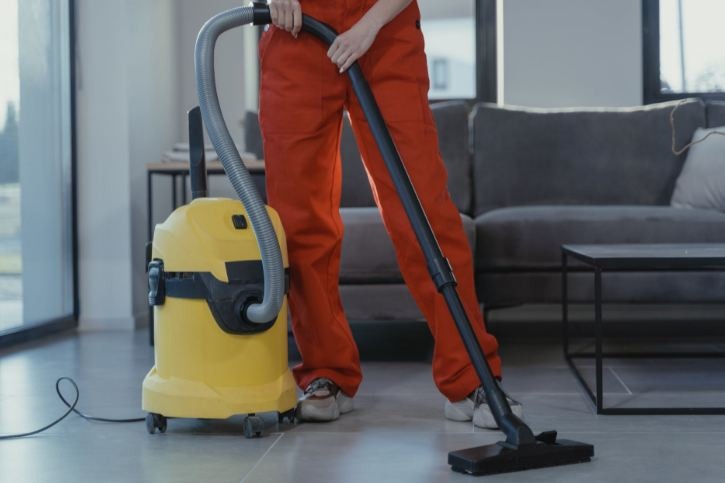Tile floors are a popular choice nowadays, thanks to the glossy, elegant look that it brings to our homes. They are also durable, low maintenance, and easily customizable, making them an excellent option among many other floor types.
Yet, like with any floor surface, proper cleaning with the right tool is a must to ensure its longevity and to keep them looking great and tidy. Often, searching for the best machines will let you see vacuum cleaners ranking on top of recommendations.
The question is – should you vacuum tile? Well, the answer is an outright yes! But, are you wondering why and how? Continue reading below as we’ll delve into this matter deeper and discover why vacuum cleaners are an essential part of cleaning your tile floors.
Why should you vacuum tile floors?
Tile floors do not retrain or trap loose dirt, dust, and soil, the same way carpets would do. Instead, they accumulate loosely on top, scratching the surface and often leaving permanent damage.
Dirt, debris, and bacteria also pile up on “unbound”, which you can quickly travel into the air, and you can inhale, causing harm to your respiratory system. Other dirt will amass in the corners, crevices, and grout lines, which must be removed as quickly as possible to avoid them from turning into sediments.
While sweeping is an excellent way to keep tile floors clean, often, they aren’t efficient enough compared to vacuuming. Using a broom poses a high likelihood of missing and leaving contaminants and debris on the floor. That’s why vacuum cleaners are the best choice, as their suction power can collect everything, ensuring a spotless clean.
How often should you vacuum tile floors?
In general, you should vacuum tile floors at least every week. However, the frequency may change depending on several factors. If you have active children who often go out outside, chances are, they are bringing more dirt or sand into your home. Thus, you must vacuum more than once a week. If you have pets, they can drop hair, dander, and fleas that can aggravate diseases or worsen allergies, making vacuuming a daily need.
If you’re busy and may not find to do daily vacuuming, a good workaround is paying attention to areas of your homes where children, other members of the household, and pets spend most of their time. These parts of the house usually include your living room, playroom, kitchen, and entryways require constant vacuuming. Meanwhile, weekly clean-up will already suffice for less-used areas of your home, such as your dining room or guest room.
Is vacuuming tile floors enough?
Though vacuum cleaners are powerful tools in cleaning tile floors and can take the place of sweeping, remember that vacuuming can’t replace mopping or vice-versa. Both are integral steps of the cleaning process and should be done subsequently.
First, you need to vacuum your tile floors to remove all the dirt and debris quickly. Afterward, you can now mop the floor with warm water and a cleaner to give the surface a beautiful shine. Special cleaners, bleach, or homemade solutions can be handy to get rid of more stubborn dirt, grime, and grout, which simple vacuuming cannot remove.
What vacuum cleaner should you buy for your tile floors?
Now that you know how essential vacuum cleaners are for tile floors, you might be enticed to purchase one right away. However, same with other purchases, you must decide carefully and take note of various considerations to ensure that you can get the best vacuum cleaner for your home. Here is a list of things you should look at:
Floor Area
One of the first things you need to consider is the total floor area. The larger the surface, the bigger vacuum you need to get for easier and quicker cleaning. If you have a bigger house, getting an upright or canister vacuum cleaner is your best bet. They are easy to handle, provide better coverage, and are ideal for hard floor cleaning.
If you live in an apartment or smaller house instead, a cordless and stick vacuum cleaner is your best ally. It features a slim design, which can reach small, narrow spaces. Plus, they are lighter and are easier to maneuver around. You will benefit more if you get a vacuum cleaner with a swivel neck design. It can turn 360 degrees, enabling you to clean up congested areas that are harder to access.
Motor Power
Next, it’s vital to check the vacuum motor. Measured in amps, the higher the motor power, the better suction power a vacuum cleaner has. Be mindful that it also entails utilizing more electricity, which may not be practical if you live in a smaller house. Simply look for a model with motor power that fits your tile floor’s cleaning needs to avoid extra expenses.
Brush and Brush Control Option
While it’s not always necessary, you may opt for a vacuum cleaner that has a motorized brush and brush control option. Rather than relying on suction alone from typical models, these specialized bristles can help the tool collect or sweep dust better, making them more effective in cleaning your tile floors. Yet, there are times that brush heads may do otherwise, so the possibility of turning the feature on and off is a huge advantage.
Versatility
To save up on the cost, consider getting a tile cleaning machine with enhanced versatility. Your tile floors aren’t the only part of the house you would be cleaning. There are shelves, ceilings, upholstery, rugs, and other areas or items that require vacuuming.
Fortunately, many vacuum cleaners offer features, such as the ability to be detached or converted into a handheld vacuum. Other models even have steaming capabilities, which work great for tile floors as they are resistant to high temperatures and can be sanitized. You can also go for wet-dry types, which can help tackle not only dust and dirt but also wet spills.
Filtration
Lastly, if anyone in your family has health conditions, look for a vacuum that has a good filtration system. It refers to the amount of dust and dirt collected from the air sucked into the vacuum cleaner and the bag. Tile floors are smooth and create an electrostatic force, causing the dust to return. A vacuum cleaner with a good filtration system ensures that no dirt will spill out, with some even capturing 99% of the dirt each time.
Final Words
Indeed, a vacuum cleaner is a labor-saving tool that can help keep your tile flooring good-looking at all times. Just be sure to get the appropriate tile-cleaning machine for your home and needs, and you’ll reap all the fantastic benefits vacuum cleaner offers. After a good vacuuming session, follow it with mopping and say hello to your glazed, immaculate tile floors.





